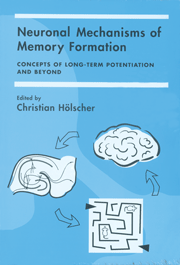Book contents
- Frontmatter
- Contents
- Contributors
- Introduction: Long-Term Potentiation as a Model for Memory Mechanisms: The Story So Far
- Section One Long-Term Potentiation In Vitro and In Vivo: How Can We Fine-Tune the Current Models for Memory Formation?
- Section Two There is More to the Picture Than Long-Term Potentiation: Theta or Gamma Oscillations in the Brain and the Facilitation of Synaptic Plasticity
- Section Three Making Models from Empirical Data of Synaptic Plasticity
- Section Four Setting the Stage for Memory Formation: Stress, Arousal, and Attention
- Section Five Transgenic Mice as Tools to Unravel the Mechanisms of Memory Formation
- Conclusions and Future Targets
- Index
Conclusions and Future Targets
Published online by Cambridge University Press: 13 October 2009
- Frontmatter
- Contents
- Contributors
- Introduction: Long-Term Potentiation as a Model for Memory Mechanisms: The Story So Far
- Section One Long-Term Potentiation In Vitro and In Vivo: How Can We Fine-Tune the Current Models for Memory Formation?
- Section Two There is More to the Picture Than Long-Term Potentiation: Theta or Gamma Oscillations in the Brain and the Facilitation of Synaptic Plasticity
- Section Three Making Models from Empirical Data of Synaptic Plasticity
- Section Four Setting the Stage for Memory Formation: Stress, Arousal, and Attention
- Section Five Transgenic Mice as Tools to Unravel the Mechanisms of Memory Formation
- Conclusions and Future Targets
- Index
Summary
Overview of the Different Chapters
The opinions expressed in the different chapters show a great variety and span the entire range from researchers who believe that long-term potentiation (LTP) is not a model of learning at all and could be an artifact (chapters by McEachern and Shaw, McNaughton, and Matzel and Shors) to those who do not see any problems with the concept of LTP as a model for learning mechanisms (Abraham, Cho and Eichenbaum, and Rogan et al.). Most authors, however, voice a more diversified opinion and suggest a “revised and improved” model of LTP and memory formation that tries to integrate our increased knowledge of how neurons communicate in living brains. Such a model could account for discrepancies observed between LTP inducibility and learning abilities that have been published so far.
Persisting with LTP As a Model for Learning and Memory Formation
While not discussing the lack of correlations between LTP inducibility and learning abilities in numerous publications, Abraham suggests in Chapter 1 that LTP [and long-term depression (LTD)] is still a useful model and the dominating theory for mechanisms of memory formation. He notes that LTP is not homogeneously expressed in areas of the brain. LTP in the dentate gyrus is usually detrimental, whereas CA1 LTP tends to be robust and nondetrimental. LTP in the cortex is difficult to induce but appears to be very stable once it has been induced. To him, these data indicate that genuine differences exist that might reflect different roles in different areas for LTP as a process of memory formation.
- Type
- Chapter
- Information
- Neuronal Mechanisms of Memory FormationConcepts of Long-term Potentiation and Beyond, pp. 476 - 490Publisher: Cambridge University PressPrint publication year: 2000



